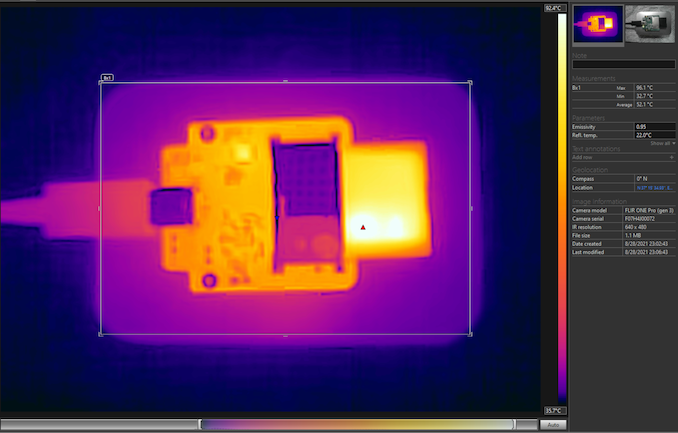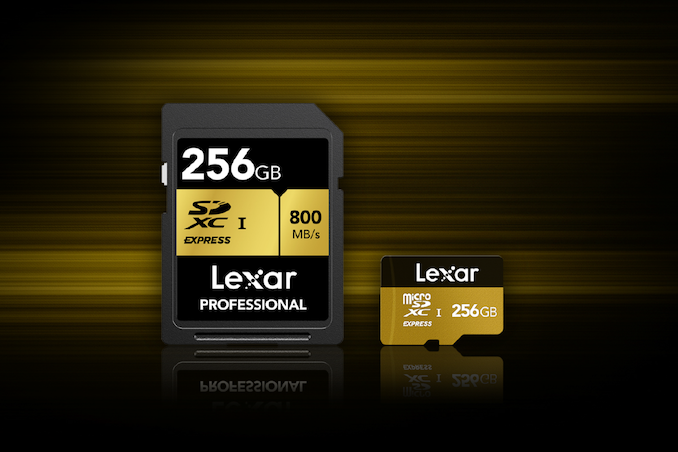Next Gen NVMe SD Card Review: The SM2708 Controller Serves it Hot and Fast
by Ganesh T S on September 9, 2021 9:00 AM EST- Posted in
- Storage
- NAND
- flash
- NVMe
- Silicon Motion
- Memory Cards
- 3D TLC
- SD Express
Miscellaneous Aspects and Concluding Remarks
The appearance of PCIe / NVMe in the memory cards space enables us to bring over some of our direct-attached storage evaluation metrics. Two important aspects are power consumption and thermal characteristics.
Power Consumption
Bus-powered devices can configure themselves to operate within the power delivery constraints of the host port. While Thunderbolt ports are guaranteed to supply up to 15W for client devices, USB 2.0 ports are guaranteed to deliver only 2.5W (500mA @ 5V). In this context, it is interesting to have a fine-grained look at the power consumption profile of the memory card / card reader combination. Using the Plugable USBC-TKEY, the bus power consumption of the drives was tracked while processing the complete test suite. The graphs below plot the instantaneous bus power consumption against time, while singling out the maximum and minimum power consumption numbers.
| Power Consumption Profile [Card + Reader] | |
| TOP: | BOTTOM: |
The Realtek card reader and the SM2708 reference design combination has a peak power consumption of 4.58W, with the average being around 3.25W. On the other hand, in UHS-I mode, the Lexar card reader and the reference design operate at less than 1.67W, with the average being around 1.25W. The extra performance in SD Express mode comes at the cost of power consumption, but that is no surprise.
Thermal Profile
The performance consistency evaluation of the reference design in SD Express mode revealed the internal temperature of the SD card to be around 100C when subject to heavy stress. In order to rule out any errors in the S.M.A.R.T polling, we used a FLIR One Pro thermal imager to capture the thermal profile of the card while being subjected to the performance consistency test.
To our dismay, we found the surface temperature to be as high as 96C - something entirely unsafe for handling with bare hands. It does look like safety standards allow for such surface temperatures, provided the device is under 50mm x 50mm in size. Unfortunately, it is a sad reality that the SD card and microSD card form-factors do not allow for the thermal design necessary to sustain extended operation with NVMe-class speeds. In any case, Silicon Motion's customers can tweak the firmware's configurable parameters to achieve a different balance between performance and temperature. The SM2708 might also held back a bit by its 28nm fabrication node. Once SD Express achieves scale of deployment, it is likely that Silicon Motion can choose more advanced nodes to drive down the power consumption and stress temperatures.
Final Words
Reviewing the Silicon Motion SM2708 reference design has helped us greatly in setting the consumer expectations for SD Express using NVMe right. The advertised numbers can only be achieved in burst mode, and sustained writes may be affected by a combination of SLC cache sizes and thermals. Performance similar to that of a high-end SATA SSD or a PCIe 3.0 x2 NVMe SSD can be expected, though the nature and number of flash pieces inside the card can heavily influence the performance.
Silicon Motion has a couple of design wins ready to ship, with ADATA and Lexar in the final stages of bringing their SD Express products into the market.
Overall, consumers have been waiting for SD Express for quite some time. While CFexpress has taken the early lead with camera / camcorder makers, SD cards have a much wider range of markets to service and target. We are bullish on the prospects for SD Express in verticals such as portable game consoles and SBCs, but it might take a few years for mid-range cameras to start supporting it.
In the meanwhile, products such as the Silicon Motion SM2708 and Realtek RTL9211DS / RTS5261 can prime the market for the new standard on the PC side. A lot is dependent on the vendors not charging too much of a premium for SD Express over the standard UHS-II cards / readers.














43 Comments
View All Comments
nandnandnand - Thursday, September 9, 2021 - link
I've asked this question myself. The volume of an SD card is about 10x that of a microSD card. You would expect it to be able to fit 4x, maybe 8x as much NAND. The largest capacity for both is still stuck at 1 TB.The first thing to do would be to go to 2 TB since it would be compatible with SDXC readers. After that, what is the market for SDUC? Some smartphones are dropping the microSD slot as the internal storage is now "good enough". Videographers may want an 8 TB full-size SD card, probably with SD Express speeds to deal with 4K/8K/360-degree video capture. Maybe the card needs to be made out of aluminum for cooling.
meacupla - Thursday, September 9, 2021 - link
If I had to guess, there is a limitation at the controller and/or reader.I doubt there is a problem with file format type, as exFAT has existed for a while now, with very high compatibility, and even if the format type was limited to FAT32, the maximum size would be 2TB
schuckles - Friday, September 10, 2021 - link
I think that pretty much all designs for SD cards attempt to support micro SD as well. So in the end the bigger size is more about consumer use case than increased capacity.nandnandnand - Friday, September 10, 2021 - link
All of the devices that support a full sized SD card should be compatible with a microSD adapter card, and pretty much all microSD cards I've seen come with an adapter (I have at least 14 of them now).There's no technical reason for SD cards to not be available in higher capacities, it comes down to the nature of the market. Maybe 10-100 times more devices are compatible with microSD because of smartphones. I wouldn't be surprised if a 2 TB microSD card gets announced before a 2 TB full-sized SD.
Nevod - Saturday, September 11, 2021 - link
Yes, there's no reason to develop additional functionality for full-size SD as market is much smaller than for microSD.Hopefully, SD Express readers may appear on notebooks and become a decent performance option to increase storage. That may provide a push to increase full-size card capacity, if price would be competitive with m.2 and USB options.
nandnandnand - Saturday, September 11, 2021 - link
I am hopeful. I've seen SD card readers on even OEM desktops I've looked at lately, and controllers like this are available:https://www.anandtech.com/show/16603/silicon-motio...
Xajel - Thursday, September 9, 2021 - link
I think one major test is left out here, performance per watt.I mean for a portable device, power is crucial here, if at that speed the card can save the exact same file much faster than a non-SD 7.1 card and eventually consumes less power then it's a win for the portable device. They can use it and get faster while consuming less power because it needs less time to save the data.
But if if the Performance/Watt was low then it's a problem, And maybe they will use a custom firmware to actually limit the performance to save power and stay within the required temperature. And the smaller the device the more crucial is to stay within low power/temp. Like mobile devices.
Using microSD Express might as well save Android from getting rid of the expandable storage due to lack of good performance on current microSDs (very low IO performance).
nandnandnand - Thursday, September 9, 2021 - link
"Using microSD Express might as well save Android from getting rid of the expandable storage due to lack of good performance on current microSDs (very low IO performance)."That would be nice, but I think the major manufacturers just want to get rid of it so they can sell you a phone with 1 TB UFS for $200 more.
meacupla - Thursday, September 9, 2021 - link
I am surprised the controller is still using 28nmdoesn't that take up a lot of space?
beginner99 - Friday, September 10, 2021 - link
"We are bullish..." Dude this isn't some hipster crypto forum...